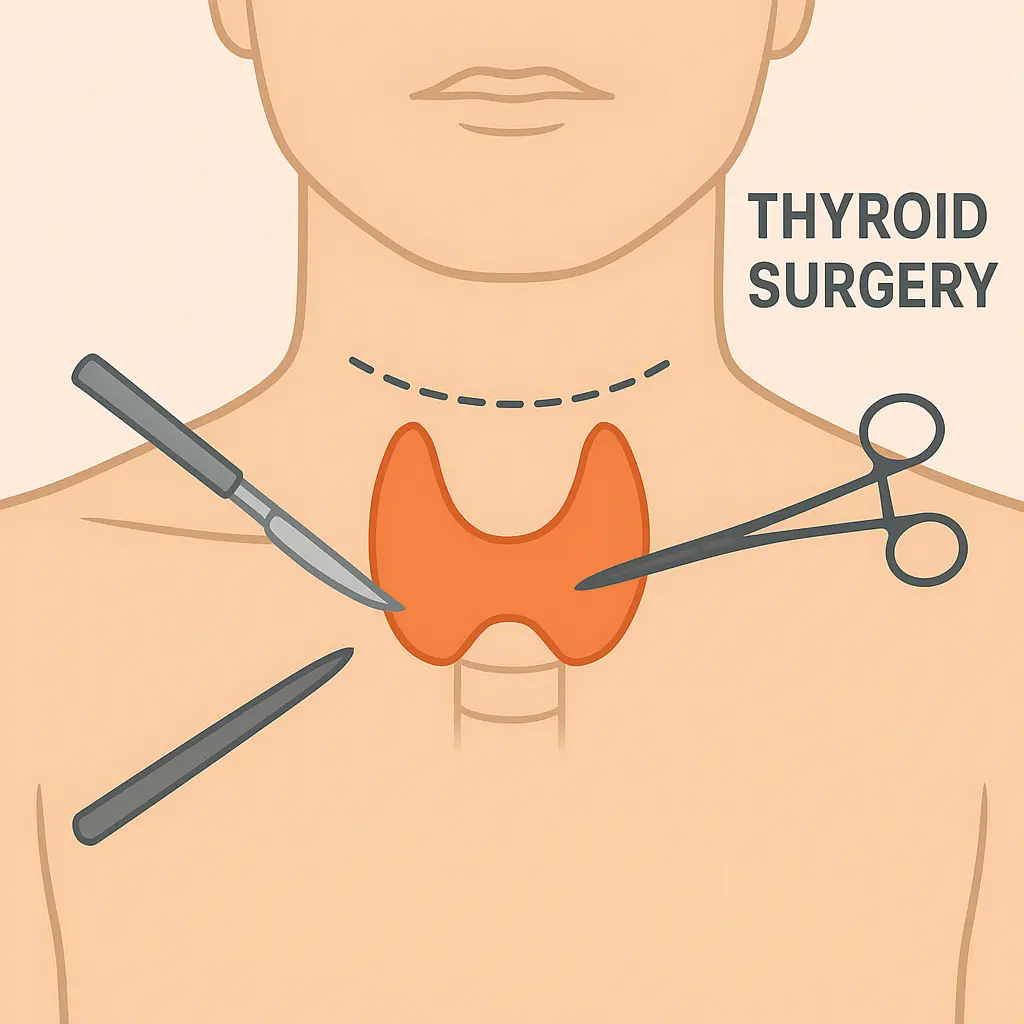Thyroid Surgery
Tired of Neck Swelling, Voice Changes, or Constant Discomfort?
Thyroid Surgery by thyroid specialist Dr. Prashant Verma can be the solution.
- Noticeable lump in the front of your neck?
- Trouble swallowing or feeling of tightness?
- Voice becoming hoarse or weak?
- Diagnosed with thyroid nodules or goiter?
- Suspicion of thyroid cancer?
What is Thyroid Disease and Why Surgery Is Sometimes Needed?
The thyroid is a small, butterfly-shaped gland in the neck that regulates metabolism, energy, and hormonal balance. But sometimes, this gland can develop issues such as nodules, enlargement (goiter), or even cancer. These conditions may cause symptoms like swelling in the neck, difficulty in breathing or swallowing, voice changes, or hormonal imbalance.
When medications or observation aren’t enough — especially in cases of large goiter, suspicious nodules, or confirmed thyroid cancer — thyroid surgery becomes essential. Dr. Prashant Verma offers safe, precise, and minimally invasive thyroid operations for lasting relief and better quality of life.
थायरॉयड की बीमारी क्या है और सर्जरी कब ज़रूरी होती है?
थायरॉयड एक तितली के आकार की ग्रंथि होती है जो गर्दन के आगे हिस्से में स्थित होती है। यह शरीर के मेटाबॉलिज्म और हार्मोन बैलेंस को नियंत्रित करती है। कई बार इसमें गाँठ (नोड्यूल), सूजन (गॉइटर), या कैंसर जैसी समस्याएं हो सकती हैं।
इसके लक्षणों में शामिल हो सकते हैं:
🧣 गर्दन में सूजन या उभार
🥴 निगलने या साँस लेने में तकलीफ़
🗣 आवाज़ में बदलाव
⚖ हार्मोन असंतुलन
अगर दवाइयां असर नहीं कर रही हों, या थायरॉयड में कैंसर या बड़ी गाँठ का संदेह हो, तो सर्जरी ज़रूरी हो जाती है। डॉ. प्रशांत वर्मा द्वारा की गई थायरॉयड सर्जरी सुरक्षित, आधुनिक और कम दर्द वाली होती है — जिससे आप जल्दी ठीक होकर सामान्य जीवन जी सकते हैं।

Meet Dr. Prashant Verma – Your Expert Gastro Surgeon
Dr. Prashant Verma, with over 23 years of experience in treating acid reflux and digestive disorders, offers expert diagnosis and advanced treatment options for long-lasting relief.
Thyroid Surgery by Dr. Prashant Verma
Dr. Prashant Verma is a highly skilled Endocrine and Laparoscopic Surgeon, with specialized expertise in thyroid surgery. He is known for performing safe, precise, and cosmetically-conscious procedures for a wide range of thyroid conditions — including thyroid nodules, goiters, and thyroid cancer.
That’s where Dr. Prashant Verma, a trusted thyroid and endocrine surgeon with expertise in minimally invasive thyroid surgery, makes all the difference.

Why Choose Dr. Prashant Verma for Thyroid Surgery?
Dr. Prashant Verma is a leading thyroid and endocrine surgeon with vast experience in diagnosing and surgically treating a wide range of thyroid conditions — from benign goiters to thyroid nodules and cancers — using safe, precise, and minimally invasive techniques.
What sets Dr. Verma apart is his root-cause, patient-centered approach. He doesn’t rush to operate — instead, he performs a detailed clinical evaluation including ultrasound, thyroid function tests, FNAC (needle biopsy), and vocal cord assessment. His goal is to determine whether surgery is necessary and which approach will ensure the best long-term outcome.
With over 23 years of surgical expertise, including advanced laparoscopic and scar-minimizing thyroid procedures, Dr. Verma ensures you get a tailored, safe, and cosmetically mindful solution — all while preserving your voice, hormonal balance, and peace of mind.
Treatments Offered for Thyroid Conditions
When medications or monitoring are not enough, Dr. Prashant Verma offers advanced solutions tailored to your thyroid condition:
Non-Surgical Management
For select thyroid conditions (like mild hypothyroidism or small benign nodules), Dr. Verma may recommend:
- Medication-based hormone therapy
- Regular ultrasound monitoring
- FNAC (Fine Needle Aspiration Cytology) for diagnosis
Surgical Treatment — Minimally Invasive & Safe
Dr. Verma specializes in safe, scar-minimizing thyroid surgeries using modern techniques:
- Asthetic Thyroidectomy (Minimal Invasive Surgery) – faster recovery
- Total Thyroidectomy – Removal of entire gland in case of cancer or severe overactivity
- Hemithyroidectomy – Partial removal when only one lobe is affected
- Completion Thyroidectomy – For patients who had prior partial surgery
- 🛌 Same-day or next-day discharge in most cases, with quick return to daily life.invasive solutions like laparoscopic GERD surgery for lasting relief.
🔍 Do You Have These Symptoms?
Many people live with undiagnosed thyroid problems, assuming it’s just “stress” or “weakness.” But Dr. Verma investigates deeper.
- He carefully evaluates both typical and hidden symptoms of thyroid conditions like goiter, nodules, hyperthyroidism, or early thyroid cancer:
- Voice changes or hoarseness
- Throat discomfort or pressure
- Difficulty swallowing (dysphagia)
- Palpitations, anxiety, or mood changes
- Constant fatigue or poor sleep
- Unexplained weight gain or loss
- Breathing difficulty due to neck swelling
Dr. Verma also screens for serious concerns like thyroid cancer or compressive goiter pressing on the windpipe — often missed in routine checkups — and ensures early diagnosis and expert surgical care when needed.
What is Thyroid Surgery?
Thyroid surgery (also called thyroidectomy) is a procedure to remove part or all of the thyroid gland, a small, butterfly-shaped gland in the neck that regulates metabolism, energy, and hormone balance. Surgery is often needed when there are nodules, goiters, or suspected thyroid cancer that require removal for diagnosis or treatment.
When is Thyroid Surgery Needed?
Thyroid surgery is recommended in cases such as:
Common Surgical Approaches
- Hemithyroidectomy – Removal of one lobe (half) of the thyroid — usually for nodules or localized issues. Preserves partial gland function.
- Total Thyroidectomy – Complete removal of the thyroid gland — typically done in cases of thyroid cancer or multinodular goiter.
- Near-Total / Subtotal Thyroidectomy – Most of the thyroid is removed, leaving behind a small portion. This may be done in specific benign conditions.
- Minimally Invasive / Endoscopic Thyroid Surgery – Small-incision or scarless approaches (from underarm or mouth) used in select cases — offering quicker recovery and minimal visible scarring.

